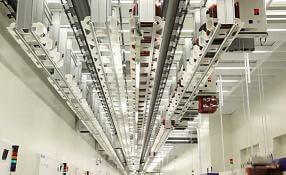Robot Domination – Look At The Making of a Memory Card

Share
Every product in your home tells a story. Listening to the memory card in your camera or computer will give you a sneak peak into the international world of automated manufacturing. Lexar Media is one of the largest producers of memory chips (SD cards, memory sticks, keydrives, CompactFlash, etc), and they recently released a promo that shows the start to finish process for their goods. What does this video demonstrate? Total automation domination. From the creation of the silicon wafer in Utah to the packaging of the final product in Asia , machines are center stage. Watching these slick industrial robots do their thing is something else. You have to check out the video below and see what I mean. Considering how crucial automation is in modern production, maybe the big surprise at this point isn't the robotic dominance but that Lexar still employs so many humans.
When you watch the following video, I want you to compare the creation of the silicon wafers in Utah to the rest of the assembly and testing performed in Asia. The wafer building at Micron Technology (which owns Lexar, by the way) displays a minimum of human presence, even if it has "thousands of workers." The factories in Asia are very different. Starting around 3:28, the process goes from being almost purely robotic to relying more on human-machine cooperation.
Be Part of the Future
Sign up to receive top stories about groundbreaking technologies and visionary thinkers from SingularityHub.


Two of the major themes in the public eye here in the US are the outsourcing of jobs abroad and the current economic crisis. We've recently explored how workers in the US are (rightfully?) concerned about losing jobs to robots as well as to overseas factories. I think the video above shows that these are, in fact, competing interests. Look at the work done in Asia: is there any doubt that many of the steps humans are performing could be automated? The plugging in of cards for testing, the assembling of components, the placement of products in packaging - I could imagine a robot doing any of these tasks. Which probably means that, in a few years or so, they will. Asia, with its relatively cheap labor markets, is where we have exported manufacturing jobs. Yet if these processes become as automated as the wafer factories in Utah would labor costs still be the deciding factor?
As robots get cheaper and better you have to pay your workers less and less to compete. At some point, machines win. And not just in manufacturing - automation is creeping in at all levels of the economy, including research science. In the years ahead, human labor is likely to be removed from any repetitive task. Manufacturing, tech services, legal research and other fields could try to make their way to even cheaper labor markets, but I think that robots will ultimately make such geographic concerns a thing of the past. Watching Lexar's tour through their creation process leaves little doubt that the domination of automation is well underway. It's only going to get more robotic from here.
[screen capture and video credit: Lexar Media]
Related Articles

These Robots Are the Size of Single Cells and Cost Just a Penny Apiece

In Wild Experiment, Surgeon Uses Robot to Remove Blood Clot in Brain 4,000 Miles Away

A Squishy New Robotic ‘Eye’ Automatically Focuses Like Our Own
What we’re reading
